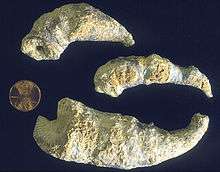Caninia (coral)
Caninia is an extinct genus of rugose coral.[1] Its fossils occur worldwide from the Devonian to the Permian periods.
| Caninia | |
|---|---|
 | |
| Caninia torquia from the Beil Limestone Member, Lecompton Limestone, Douglas County, Kansas | |
| Scientific classification | |
| Kingdom: | Animalia |
| Phylum: | Cnidaria |
| Class: | Anthozoa |
| Order: | †Rugosa |
| Family: | †Cyathopsidae |
| Genus: | †Caninia Michelin 1840 |
Paleoecology
It was marine in nature and known to live in lagoon-type ecosystems.[2] Because of the shallow water in which it lived, Caninia was often affected by processes above the water level, such as storms.[3]
Distribution
| Place name | formation | Age |
|---|---|---|
| "Worldwide" | Devonian [4] | |
| Arkansas | Fayetteville Shale, Pitkin Limestone | Mississippian [5][6] |
| Illinois | Mississippian [6] | |
| Oklahoma | Fayetteville Shale | Mississippian [6] |
| Montana | Otter Formation | Mississippian [7] |
| New Mexico | Lake Valley Formation | Mississippian [2] |
| Kansas | Lecompton Limestone | Pennsylvanian [8] |
| Nevada (Ely basin) | Chainman Shale | (Early) Pennsylvanian [9] |
| Texas | Cisco Group | Pennsylvanian [10] |
| Wales (South) | Arundian Limestone, High Tor Limestone | Carboniferous [3][11] |
| Vancouver Island | Buttle Lake Formation | Permian [12] |
gollark: ++about
gollark: Weird.
gollark: ++magic py bot.guilds
gollark: Huh.
gollark: ++magic py len(bot.guilds)
References
- "Fossil Corals". Archived from the original on 2012-06-14. Retrieved 2012-11-11.
- Jeffords, Russel. 1943. Caninia from the Lower Carboniferous of New Mexico. Journal of Paleontology. vol. 17. no. 6.
- Wu, Xian-tao. 1982. Storm-generated depositional types and associated trace fossils in Lower Carboniferous shallow-marine carbonates of Three Cliffs Bay and Ogmore-by-Sea, South Wales. Palaeogeography, Palaeoclimatology, Palaeoecology. vol.39. issue 3-4.
- Shimer and Shock. 1944. Index Fossils of North America. MIT Press. Boston. pg. 91.
- Easton, W.H. 1943. The Fauna of the Pitkin Formation of Arkansas. Journal of Paleontology: vol. 17. no. 2.
- Easton, W.H. 1945. Amplexoid Corals from the Chester of Illinois and Arkansas. Journal of Paleontology: vol. 19. no. 6.
- Easton, W.H. 1945. Corals from the Otter Formation (Mississippian) of Montana. Journal of Paleontology: vol. 19. no. 5.
- "Kansas Geological Survey". Archived from the original on 2012-06-14. Retrieved 2012-11-11.
- Coogan, Alan. 1964. Early Pennsylvanian History of Ely Basin, Nevada. AAAPG Bulletin. vol. 48 no. 4.
- Waller, T.H. 1969. Lower Cisco Carbonate Deposition in North-Central Texas. A Guidebook to the Late Pennsylvanian Shelf Sediments, North-Central Texas. pp. 34-39.
- Beus, Stanly. Fossil Associations in the High Tor Limestone (Lower Carboniferous) of South Wales. Journal of Paleontology. vol. 58. no. 3.
- Ludvigsen, Rolf & Beard, Graham. 1997. West Coast Fossils: A Guide to the Ancient Life of Vancouver Island. pg. 67
This article is issued from Wikipedia. The text is licensed under Creative Commons - Attribution - Sharealike. Additional terms may apply for the media files.